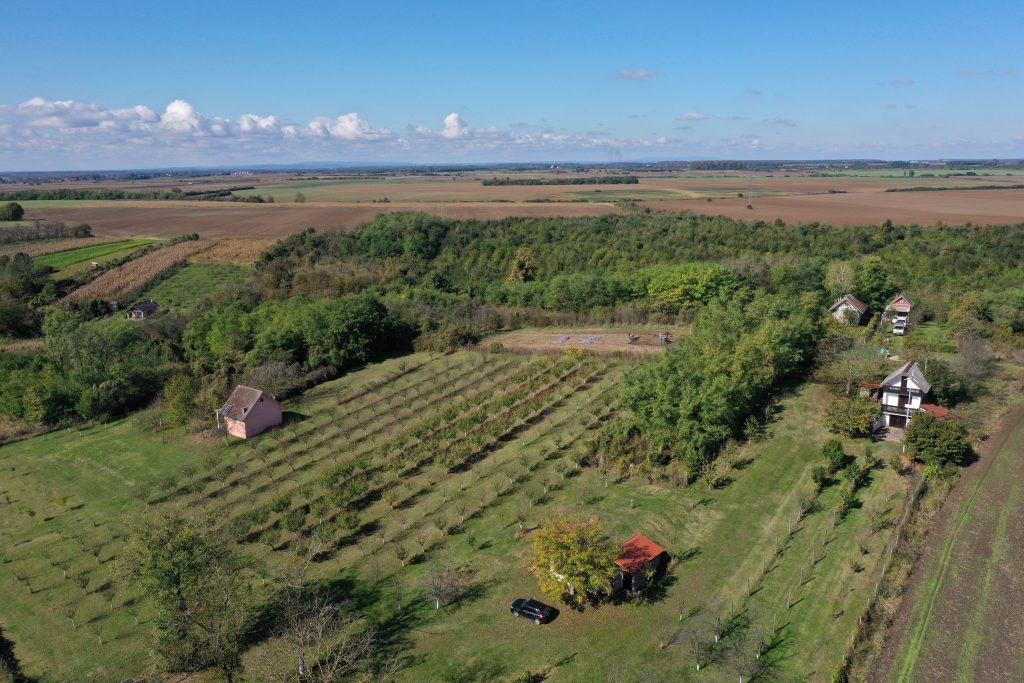Project duration: 18.12.2023. – 17.12.2027.
Project leader: Ina Miloglav, PhD, Associate Professor, University of Zagreb, Faculty of Humanities and Social Sciences, Department of Archaeology
The proposed project aims to identify changes in dietary practices in the Copper Age in Eastern Slavonia, regionally and diachronically. It also aims to identify possible causes of changes in culinary activities and strategies for plant and animal exploitation and explore how adaptations in the food economy can be linked to social and technological transformations. The geographical area between Vinkovci, Đakovo, and Slavonski Brod was chosen as the research area, covering the period from the middle to late Copper Age.
The case study will take into account the multi-period site Prisunjača in Vođinci, near Vinkovci, and for spatial and diachronic comparison, the material for analysis and sampling will be taken from 4 sites: Viškovci near Đakovo (Baden and late Vučedol culture), Verušed near Đakovo (Baden, Kostolac and Vučedol cultures), Ervenica in Vinkovci (classical Vučedol culture) and Glogovica-Medvođe near Slavonski Brod (Retz-Gajary culture).

Analyses of dietary habits and culinary practices relates to wider issues of environmental management and land use strategies. necessitating an interdisciplinary, systematic, and methodological approach to research. The core of the research proposal is formed around an integrated approach to a project theme w here each methodological step is linked horizontally and vertically and will include: functional analysis of pottery (primary classification, use-alteration analysis, organic residue analysis, and technological analysis); archaeobotanical (macro and microbotanical) and palynological analyses; archaeozoological, and stable isotope and the radiocarbon analyses. An international research team composed of experts from different scientific disciplines (archaeology, geology, chemistry, biology) with its competencies and experience will contribute to the achievement of project objectives, developing new theories, insights, and models of social dynamics in the project area, and establish scientific protocols for data collection, storage, and processing. Given that the Copper Age has been the least researched prehistoric period in Croatia, and because we have very modest and scarce data, project results, including an integrated methodological approach that has not been applied so far in Croatia, will fill the gaps with new knowledge about the economy, food practices, land use and environmental adaptation of the population at that time.
To achieve the project objectives, the research methodology will include:
1) A functional analysis of ceramic vessels involving several steps:
a) Primary classification based on morphometric characteristics
b) Use-alteration analysis – will be performed by macroscopic and microscopic techniques, and 3D models of selected ceramic pots and fragments will be used to identify food preparation and processing activities to establish a more precise classification of use-alteration traces;
c) Organic residue analysis – Gas chromatography-mass spectrometry (GC-MS) analysis will be carried out and the results will allow data on fats of plant and animal origin and on culinary activities
d) Technological analyses – X-ray diffraction (XRD) and optical microscopy will be analysed on the selected samples to identify similarities and/or differences in clay paste related to the different functions of the vessels and specific food preparation
2) Spatial analyses – will include material distribution, context, and disposal patterns of pottery and waste disposal patterns inside and outside settlements
3) Archaeobotanical analyses – will be carried out to identify plant species and plant preparation and consumption activities. The analyses will include:
a) macrobotanical analyses – to identify plant species (cereals, legumes, weeds) and their representation in the economies of the communities observed
b) microbotanical analyses – residues of starch and phytoliths on the vessels will be analysed to reconstruct processes related to the preparation/consumption/storage of foods of plant origin and the entire life cycle of the crops, from storage to disposal
4) Archaeozoological analyses – will be carried out for identification of animal species and activities related to the breeding and consumption of animals. This segment will also include:
a) stable isotope analysis – to study the patterns of herding and their mobility and to reconstruct the changes that have taken place in the diet and the environment;
5) Palynological analyses – will allow the reconstruction of paleoenvironmental factors, i.e. to determine the dynamics of climate and vegetation change and land-use
6) Development of a chronology model – to make a Bayesian model of absolute chronology for the Copper Age
